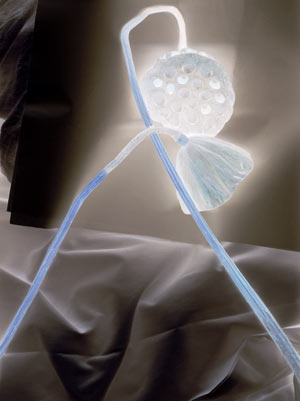| Visual Arts | China | ||||||||||||||||||||||||||||||||||||||||||||||
BAFA © 2010. All material here is copyrighted. See conditions above. |
Wang Xin
painting, drawing, photography, P.R. China. |

Wang Xin and Zhongming Qiu, 2004 Photo: S. van Kerkhoff. | Wang Xin, born 1964, Xingtai, China, started having lessons in calligraphy and painting from the age of eight. From 1983 to 1988 he was a designer for an advertising and printing agency, and in 1991 he graduated in traditional Chinese Painting at the Sichuan Academy of Fine Arts. |
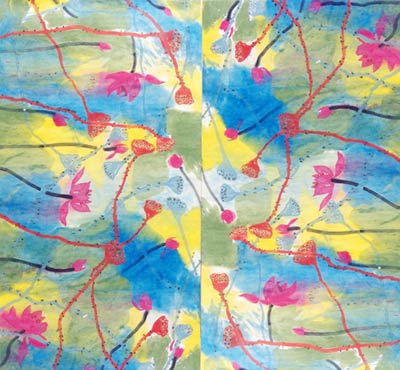
title 1, 200?, watercolour on paper?, ?cm x ?cm |
"My works vary from calligraphy, seal inscription to landscape, flowers and birds, and to figures. Using traditional Chinese paints, ink, brush and rice paper, together with such western aesthetic factors as an abstract use of composition, colour and visual interplay, my work shows a fusing of western art into Chinese art. A diversity and unity. The past five years has seen a flowering of my interest in the lotus (water lily)." - 2004. |
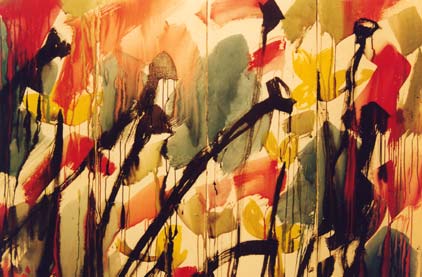
title 2, 200?, watercolour on paper?, ?cm x ?cm | Flowers of One Garden |
|
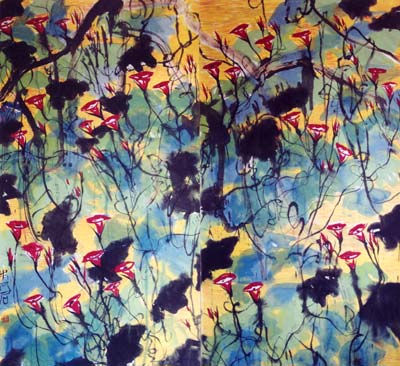
Pastoral, 2004, watercolour on paper?, ?cm x ?cm | The Lotus Project
The flower's characteristics show its hollow stem (in Chinese, "xu xin") a symbol of humility, while the straightness of its stem (in Chinese, "zhi shuai") symbolizes directness and being upright (not stooping to flattery). The flower emerges out of dirty silt ("chu wu ni er bu ran") a symbol of the flower's purity and persistence or tenacity despite a dirty and difficult environment. |
It blossoms in summer, perishes in autumn and winter, and roots in its own seeds, re-germinates and blossoms again next spring and summer. So its own life cycle is also seen as a symbol for rebirth.
|
| A few examples are "The pedestal of lotus" (the pedestal on which a Buddha sits), the seven lotuses symbolizing the birth of Buddha, and the lotus in the hand of Avalokitesvara. A lot of Chinese folk art and even Christian architecture, ceramics, folk painting and papercuts, use the motif or theme of the lotus. A contemporary example from another perspective is the Bahá´í House of Worship in New Delhi, India, also known as the "Lotus Temple". |

The Indian Bahá’í House of Worship designed by Fariburz Sahba. Photograph by Francisco González Pérez from his book: Arquitectos de Unidad (Architecture of Unity) featuring photographs of the seven Bahá`í Temples around the world, published in 2001 by Centro Andaluz de la Fotografía, Spain. |
Over the centuries, the lotus motif has developed in the Asian context to now symbolize - peace (in Chinese, "lotus" is "he" which is the first character of "he ping", meaning "peace").
|
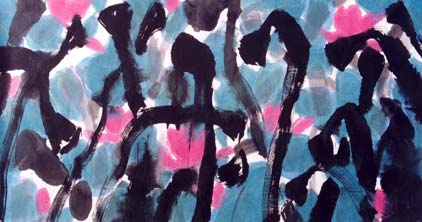
Lotuses, 200?, watercolour on paper?, ?cm x ?cm | For the past 5 years I have been focussing on a series of 'Lotus' paintings. My diverse 'lotuses' change on sunny or rainy days, in the evening or dawn, in the heat of summer or cold of winter. Nevertheless the spirit of these lotus paintings is constant. The diversity and unity of these paintings are like a large garden of flowers of different colors and shapes nurtured by the same sun and dewdrops. |
| I think that we should always search for transcendence and the lotus is a symbol of transcendence for me and hopefully for not only others in the east but the rest of the world. It is my wish to scatter the seeds of peace to every corner of the world. In thinking about this, I am looking at ways of creating an art project that is global where my lotuses will go out to all peoples. Perhaps I could work through the United Nations or some other organization where I would donate one 2 by 2 metre painting of the lotus to each country. Every country would have one original work and perhaps copies (such as a silkscreen print) of the whole set of the other paintings. I am still looking at ways of doing this as it is also important that the project has more symbolic meaning than just a collection of paintings. My idea for The Lotus Project is not limited to painting. It is a theme that I express in other media as well. At the South Korean Nine Heads International Art Symposium (April 2005) I will make an installation on the theme of the lotus and I have also made some designs for a public sculpture also based on the Lotus motif. |
|
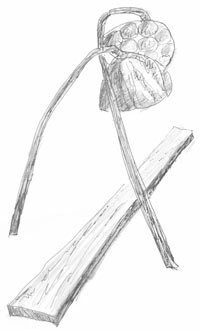
Drawing for a public sculpture, 2004 |
Drawing for a public sculpture, 2004 |
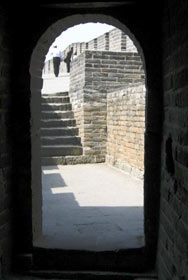
| 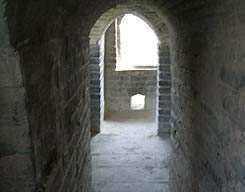 A Gate-tower at Mutianyu, The Chinese Great Wall. A Gate-tower at Mutianyu, The Chinese Great Wall. Photographs by Wang Xin, May 2005. |
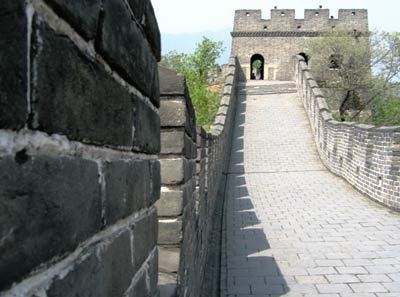 | 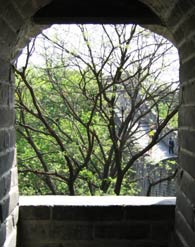 Mutianyu, The Great Wall. Photographs by Wang Xin, May 2005. |
 | 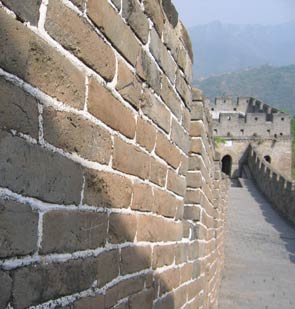 |
Mutianyu, The Great Wall.
Photographs by Wang Xin, May 2005. |
 |  |
 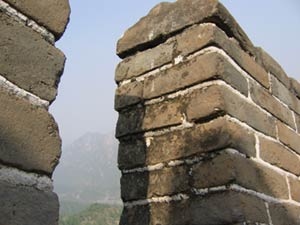 | 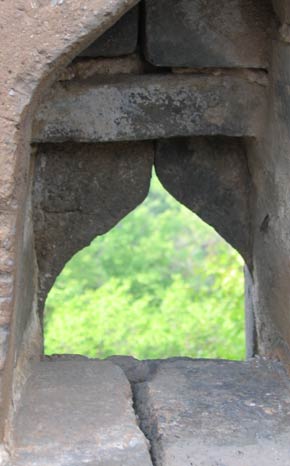 |
Mutianyu, The Great Wall.
Photographs by Wang Xin, May 2005. |
|
Arts Dialogue, Dintel 20, NL 7333 MC, Apeldoorn, The Netherlands email: bafa@bahai-library.com |
 should be no barriers between them. I refer to these links as a "cosmopolitan spirit". I believe that all the excellent arts around our globe are just like flowers of different colors and shapes in a same garden. Flowers that are nurtured by the same sun. Flowers fragrant and beautiful that share the same quality.
should be no barriers between them. I refer to these links as a "cosmopolitan spirit". I believe that all the excellent arts around our globe are just like flowers of different colors and shapes in a same garden. Flowers that are nurtured by the same sun. Flowers fragrant and beautiful that share the same quality. 